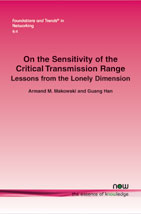On the Sensitivity of the Critical Transmission Range: Lessons from the Lonely Dimension
By Armand M. Makowski, Department of Electrical and Computer Engineering, and Institute for System Research, University of Maryland, USA, armand@isr.umd.edu | Guang Han, SAP, USA, guang.han@sap.com
Abstract
We consider geometric random graphs where n points are distributed independently on the unit interval [0, 1] according to some probability distribution function F with density function f. Two nodes communicate with each other if their distance is less than some transmission range. For this class of random graphs, we survey results concerning the existence of zero-one laws for graph connectivity, the type of the zero-one law obtained under specific assumptions on the density function f, the form of its critical scaling and its dependence on f, and the width of the corresponding phase transitions. This is motivated by the desire to understand how node distribution affects the critical transmission range as specified by the disk model. Engineering implications are discussed for power allocation.
On the Sensitivity of the Critical Transmission Range
In large-scale ad-hoc wireless networks, individual nodes communicate directly and reliably only with their neighbors, namely those nodes within their transmission range. A basic question is to determine the critical transmission range, that is, the smallest transmission range value that enables network connectivity amongst participating nodes. On the sensitivity of the critical transmission range: Lessons from the lonely dimension discusses this important resource allocation issue in the context of a simple one-dimensional disk model. It carefully explores how properties of the node distribution affect the critical transmission range, and develop engineering implications for power allocation. Interest in the one-dimensional stems from the fact that a complete set of results is available in that case, suggesting appropriate versions in the less developed higher dimensional situation, possibly by formal transfer.
